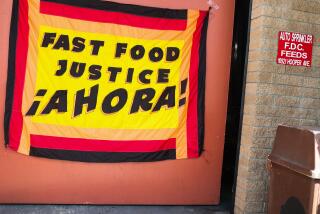How many calories are in that Big Apple?
- Share via
NEW YORK — From $2 dim sum to $150 foie-gras-and-truffle burgers, New York is a city that always eats -- and often out.
But lately, the restaurant table has become a battleground.
New city rules require chain restaurants to display calorie counts on menus. A restaurant lobbying group sued in federal court in January to prevent the city from enforcing the requirement, which is due to take effect at the end of this month.
Proponents of the calorie disclosure say the measure will help diners make informed choices. More than half of the city’s adult population is overweight, and the city’s number of diabetes cases has doubled over the last decade.
Opponents say that restaurants are willing to provide the information but that it’s a costly one-size-fits-all regulation. Smaller chains that change their menus often will be hit especially hard, they say.
Though the regulations apply only to chains with at least 15 locations nationwide -- about 10% of the city’s restaurants -- the New York State Restaurant Assn. is concerned that the rules will be extended to every city restaurant.
“The camel puts his nose in the tent and the next thing you know, he’s in the tent,” said Executive Vice President Chuck Hunt.
Chain restaurants are the focus, health officials say, because they tend to offer high-calorie dishes and large portions. And chains’ standardization means the rules will be easier to enforce, they say. Similar legislation has been passed in Seattle and San Francisco and is pending in many cities and states. In California, Gov. Arnold Schwarzenegger vetoed a food-labeling bill last year that had been heavily opposed by the California Restaurant Assn.
Mayor Michael R. Bloomberg, a hot dog aficionado, has made improving New Yorkers’ health a priority. Last week, he introduced the Green Carts program, which aims to bring more produce vendors to poorer neighborhoods.
Five years ago, the city pushed through a smoking ban in bars and eateries despite loud resistance. Officials then set their sights on artificial trans fats, voting in 2006 to ban the artery-clogging frying oils.
Last year, a judge struck down the city’s first effort to mandate nutritional information on menus. After the Board of Health revived the measure, the New York State Restaurant Assn. sued. A judge is considering the matter.
In a National Restaurant Assn. statement when the suit was filed, Senior Vice President John Gay said: “The New York City Board of Health has once again pushed forward a misguided regulation that would punish the city’s restaurants, many of whom are already providing comprehensive and accurate nutrition information to customers in convenient ways, both in the restaurant and on the Web.”
McDonald’s, Burger King, Starbucks and other chains already provide nutritional information on posters, tray liners, food wrappers or the Internet -- disclosing, for example, that a McDonald’s Deluxe Breakfast with a regular-size biscuit without margarine or syrup has 1,070 calories -- about half the recommended daily intake for a typical adult.
But diners rarely see the information and generally underestimate how many calories they consume, said Marion Nestle, professor of nutrition and food studies at New York University.
“People don’t understand calories very well,” said Nestle. “They have no idea how many calories they are eating.” Giving people a better understanding of their calorie intake will save tax dollars by helping to prevent diabetes and obesity-related illnesses, she said.
Obesity currently costs about $78.5 billion a year nationally, according to the Centers for Disease Control and Prevention.
Though there have been no comprehensive studies on how diners use nutrition labels, the city Health Department thinks the new rules could prevent more than 30,000 cases of diabetes and reduce the number of obesity cases by 150,000 over the next five years.
“It’s worth a try,” said Nestle.
To Dan Barber, executive chef and co-owner of the restaurants Blue Hill at Stone Barns and Blue Hill in Manhattan, the debate about food labeling is misguided because it ignores how disconnected from food people have become.
“What I would propose, if I was in charge, is an origin of farm label -- that wouldn’t be intrusive but pleasurable because it would connect us back to our food,” said Barber. His menus are dominated by locally produced food.
Today’s nutritional labeling is “an indication of a society that has a complicated relationship with food,” he said. “We’ve lost our way.”
--
More to Read
Sign up for Essential California
The most important California stories and recommendations in your inbox every morning.
You may occasionally receive promotional content from the Los Angeles Times.













